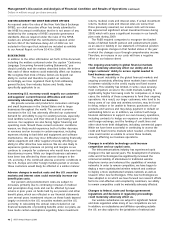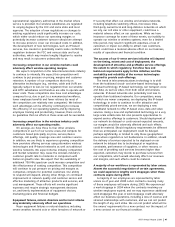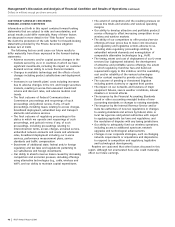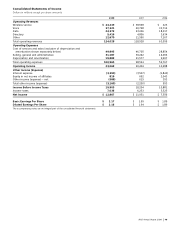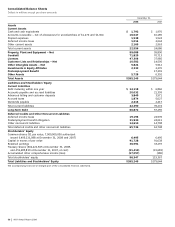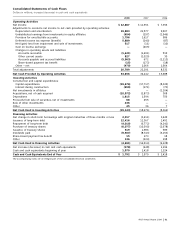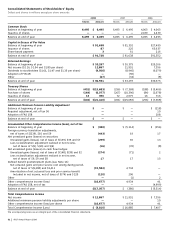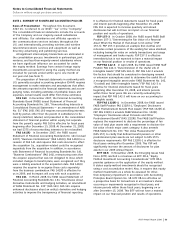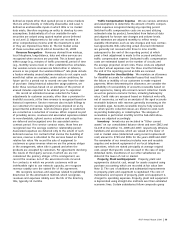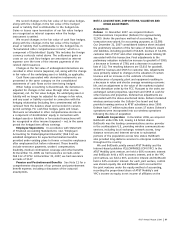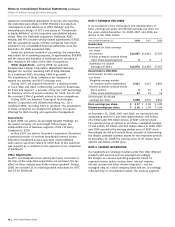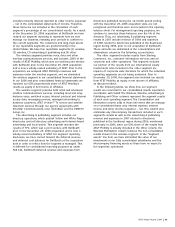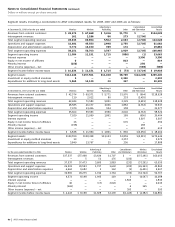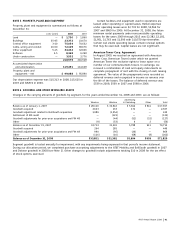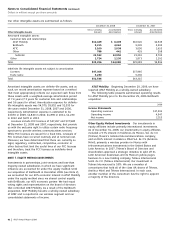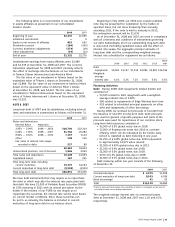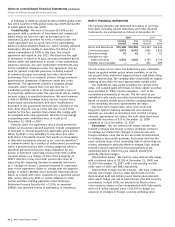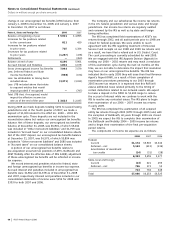AT&T Wireless 2008 Annual Report Download - page 58
Download and view the complete annual report
Please find page 58 of the 2008 AT&T Wireless annual report below. You can navigate through the pages in the report by either clicking on the pages listed below, or by using the keyword search tool below to find specific information within the annual report.
Notes to Consolidated Financial Statements (continued)
Dollars in millions except per share amounts
56
| AT&T Annual Report 2008
depreciation methodology; accordingly, when a portion of
their depreciable property, plant and equipment is retired
in the ordinary course of business, the gross book value is
reclassified to accumulated depreciation; no gain or loss is
recognized on the disposition of this plant.
Property, plant and equipment is reviewed for recoverability
whenever events or changes in circumstances indicate that
the carrying amount may not be recoverable. An impairment
loss shall be recognized only if the carrying amount of a
long-lived asset is not recoverable and exceeds its fair value.
The carrying amount of a long-lived asset is not recoverable
if it exceeds the sum of the undiscounted cash flows expected
to result from the use and eventual disposition of the asset.
The fair value of a liability for an asset retirement
obligation is recorded in the period in which it is incurred
if a reasonable estimate of fair value can be made. In periods
subsequent to initial measurement, period-to-period changes
in the liability for an asset retirement obligation resulting
from the passage of time and revisions to either the timing
or the amount of the original estimate of undiscounted cash
flows are recognized. The increase in the carrying value of
the associated long-lived asset is depreciated over the
corresponding estimated economic life.
Software Costs It is our policy to capitalize certain costs
incurred in connection with developing or obtaining internal-
use software. Capitalized software costs are included in
“Property, Plant and Equipment” on our consolidated balance
sheets and are primarily amortized over a three-year period.
Software costs that do not meet capitalization criteria are
expensed immediately.
Goodwill and Other Intangible Assets Goodwill represents
the excess of consideration paid over the fair value of net
assets acquired in business combinations. Goodwill and other
indefinite-lived intangible assets are not amortized but are
tested at least annually for impairment. We have completed
our annual impairment testing for 2008 and determined
that no impairment exists.
Intangible assets that have finite useful lives are amortized
over their useful lives, a weighted average of 7.4 years.
Customer relationships are amortized using primarily the
sum-of-the-months-digits method of amortization over the
expected period in which those relationships are expected to
contribute to our future cash flows based in such a way as to
allocate it as equitably as possible to periods during which we
expect to benefit from those relationships.
A significant portion of intangible assets in our wireless
segment are Federal Communications Commission (FCC)
licenses that provide us with the exclusive right to utilize certain
radio frequency spectrum to provide wireless communications
services. While FCC licenses are issued for a fixed time, renewals
of FCC licenses have occurred routinely and at nominal cost.
Moreover, we have determined that there are currently no legal,
regulatory, contractual, competitive, economic or other factors
that limit the useful lives of our FCC licenses, and therefore
the FCC licenses are an indefinite-lived intangible asset under
the provisions of Statement of Financial Accounting Standards
No. 142, “Goodwill and Other Intangible Assets.”
In accordance with EITF No. 02-7, “Unit of Accounting
for Testing Impairment of Indefinite-Lived Intangible Assets,”
we test FCC licenses for impairment on an aggregate basis,
consistent with the management of the business on a national
scope. During the fourth quarter of 2008, we completed
the annual impairment tests for indefinite-lived FCC licenses.
These annual impairment tests resulted in no impairment
of indefinite-lived FCC licenses.
Advertising Costs Advertising costs for advertising
products and services or for promoting our corporate image
are expensed as incurred.
Foreign Currency Translation Our foreign investments
and foreign subsidiaries generally report their earnings in
their local currencies. We translate our share of their foreign
assets and liabilities at exchange rates in effect at the balance
sheet dates. We translate our share of their revenues and
expenses using average rates during the year. The resulting
foreign currency translation adjustments are recorded as a
separate component of accumulated other comprehensive
income in the accompanying consolidated balance sheets.
Gains and losses resulting from exchange-rate changes on
transactions denominated in a currency other than the local
currency are included in earnings as incurred.
We have also entered into foreign currency contracts to
minimize our exposure to risk of adverse changes in currency
exchange rates. We are subject to foreign exchange risk for
foreign currency-denominated transactions, such as debt
issued, recognized payables and receivables and forecasted
transactions. At December 31, 2008, our foreign currency
exposures were principally Mexican pesos, Euros, Danish
krone, Swedish krona and Canadian dollars.
Derivative Financial Instruments We record derivatives
on the balance sheet at fair value. We do not invest in
derivatives for trading purposes. We use derivatives from
time to time as part of our strategy to manage risks
associated with our contractual commitments. These
derivatives are designated as either a hedge of the fair
value of a recognized asset or liability or of an unrecognized
firm commitment (fair value hedge), or a hedge of a
forecasted transaction or of the variability of cash flows
to be received or paid related to a recognized asset
or liability (cash flow hedge). Our derivative financial
instruments primarily include interest rate swap agreements
and foreign currency exchange contracts. For example,
we use interest rate swaps to manage our exposure to
changes in interest rates on our debt obligations (see
Note 9). We account for our interest rate swaps using
mark-to-market accounting and include gains or losses
from interest rate swaps when paid or received in interest
expense in our consolidated statements of income.
Amounts paid or received on interest rate forward
contracts are amortized over the period of the related
interest payments.
All other derivatives are not formally designated for
accounting purposes (undesignated). These derivatives,
although undesignated for accounting purposes, are entered
into to hedge economic risks.


